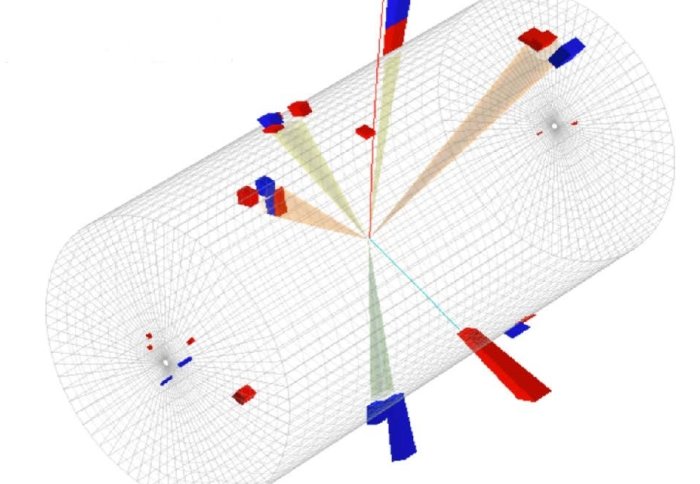New measurements of Higgs boson deepen our understanding of the origin of mass

Data from the CMS detector
A key property of the Higgs boson, which had been predicted but never observed, has been confirmed today with unprecedented precision.
The new result, from a team including Imperial College London scientists, is the first direct observation of a crucial property of the Higgs boson and its role in giving particles mass.
Deepening our understanding of the Higgs boson illuminates some of the greatest mysteries of our universe. Professor Gavin Davies
The measurement agrees with predictions based on the physics we know – called the Standard Model – and deepens our understanding of the subatomic world.
The Higgs boson gives all particles mass, and since its first detection in 2012 scientists have been probing its properties to learn more about the origin of mass. In particular, they have studied its interaction with other subatomic particles – those that are much smaller than atoms, such as quarks.
Quarks come in several different types including those that make up protons and neutrons, which form the cores of atoms. The heaviest of the quarks is the ‘top’ quark. Because it is the heaviest, it is expected to interact most strongly with the Higgs boson, therefore giving it the most mass.
Measuring this interaction has therefore been a key aim of investigations into the Higgs boson, as it would provide a better understanding of the Standard model, and where any gaps might be.
Greatest mysteries of our universe
However, Higgs boson interactions with top quarks have been difficult to observe. Now, two detectors based at the Large Hadron Collider at CERN have today reported the first direct observation of Higgs-top quark interactions.
The two detectors, CMS and ATLAS, today report consistent results that are in line with predictions from the Standard Model. The team of scientists involved in the CMS detector, which first reported its results in April, include many Imperial College London researchers.
Professor Gavin Davies, from the Department of Physics at Imperial, is the current UK principal investigator for the CMS collaboration. He said: “It’s particularly pleasing that the observation of this new production mode continues Imperial’s long history in the Higgs sector. Deepening our understanding of the Higgs boson illuminates some of the greatest mysteries of our universe.”
Quick decay
The new measurement relied on detection of a rare process: the production of a Higgs boson together with a top quark and a top anti-quark, the antimatter version of a quark. It is estimated that only one per cent of Higgs bosons are produced in this way, which is called ttH production.
It’s very nice to look up for a moment and realize we have made a fundamental contribution to understanding the origin of mass. Dr Thomas Strebler
The two quarks produced quickly annihilate each other, and the Higgs boson quickly decays into other subatomic particles. This quick decay means extremely fast and precise instruments are needed, as well as advanced data analysis techniques.
The team were able to measure the Higgs interaction with top quarks by measuring multiple possible decay paths into different combinations of other particles. These measurements were then combined to determine the magnitude of original Higgs-top quark interaction.
Having achieved the first observation, the team say the detectors will take even more precise measurements in the future that could reveal differences to the Standard Model predictions.
Fundamental contribution
The Imperial team, which includes several PhD students and postdocs, led on the detection and analysis of two major decay paths: into diphoton (pairs of photons) and ditau (pairs of taus). They also led on the combination analysis of all the decay path results.
Dr Seth Zenz, Imperial physicist and co-convener of the CMS Higgs to diphoton physics group, said: "The Higgs decay to diphotons was instrumental in the Higgs discovery in 2012, and again it plays an important role here."
Dr Thomas Strebler, Imperial physicist and lead analyser, added: “It’s very nice to look up for a moment and realize we have made a fundamental contribution to understanding the origin of mass."
-
'Observation of ttH Production' by A. M. Sirunyan et al. (CMS Collaboration) is published in Physical Review Letters.
-
Image credit: CERN
Article text (excluding photos or graphics) © Imperial College London.
Photos and graphics subject to third party copyright used with permission or © Imperial College London.
Reporter
Hayley Dunning
Communications Division